Project managers spend up to 20 hours weekly on admin tasks. Generative AI in project management can change that.
Instead of manually drafting reports, chasing updates, and making predictions based on limited data, AI can handle routine work while you focus on strategy, stakeholder relationships, and complex problem-solving.
In this article, you’ll learn:
- 10 real-world applications of generative AI in project management
- How to select and implement the right AI tools for your stack
- 5 verified case studies showing measurable AI wins
- Common myths that sabotage GenAI implementation
- Tactical strategies to avoid costly mistakes
10 practical applications of generative AI for project managers: Full overview
Project managers use generative AI to eliminate routine administrative tasks and make data-driven decisions faster. The technology handles everything from documentation creation to risk prediction.
These AI tools integrate directly into existing project workflows. They provide real-time insights and automate time-consuming processes that previously required manual effort.
Key applications include:
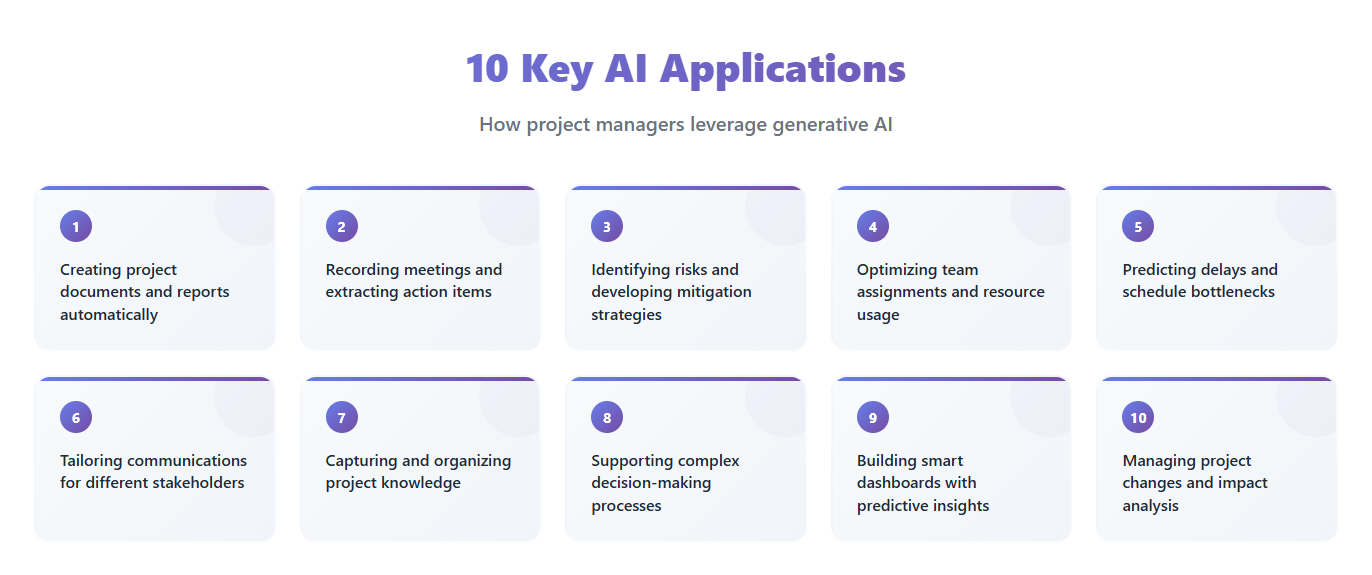
1. Automated documentation generation
Say goodbye to hours spent drafting project documentation. Generative AI can now automatically create:
- Comprehensive project plans based on minimal input parameters
- Detailed technical specifications from simple project briefs
- Automated status reports that compile data from multiple sources
- Custom templates for recurring documentation needs
By implementing tools that automatically generate documentation, project managers can reduce administrative overhead by up to 70%.
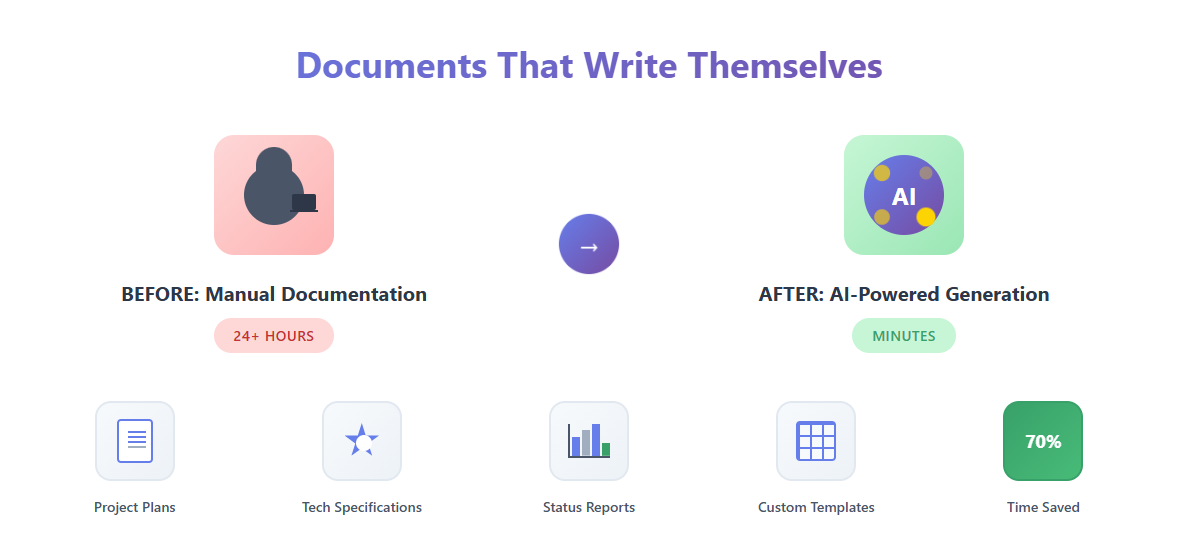
2. Meeting summaries and action item extraction
Meetings are essential, but can consume valuable time. AI-powered tools enable:
- Real-time transcription of project meetings
- Automatic identification of key decisions made during discussions
- Extraction and assignment of action items to team members
- Creation of searchable meeting archives
Using AI in project management for meeting transcription and action tracking ensures no detail falls through the cracks and enhances team alignment.
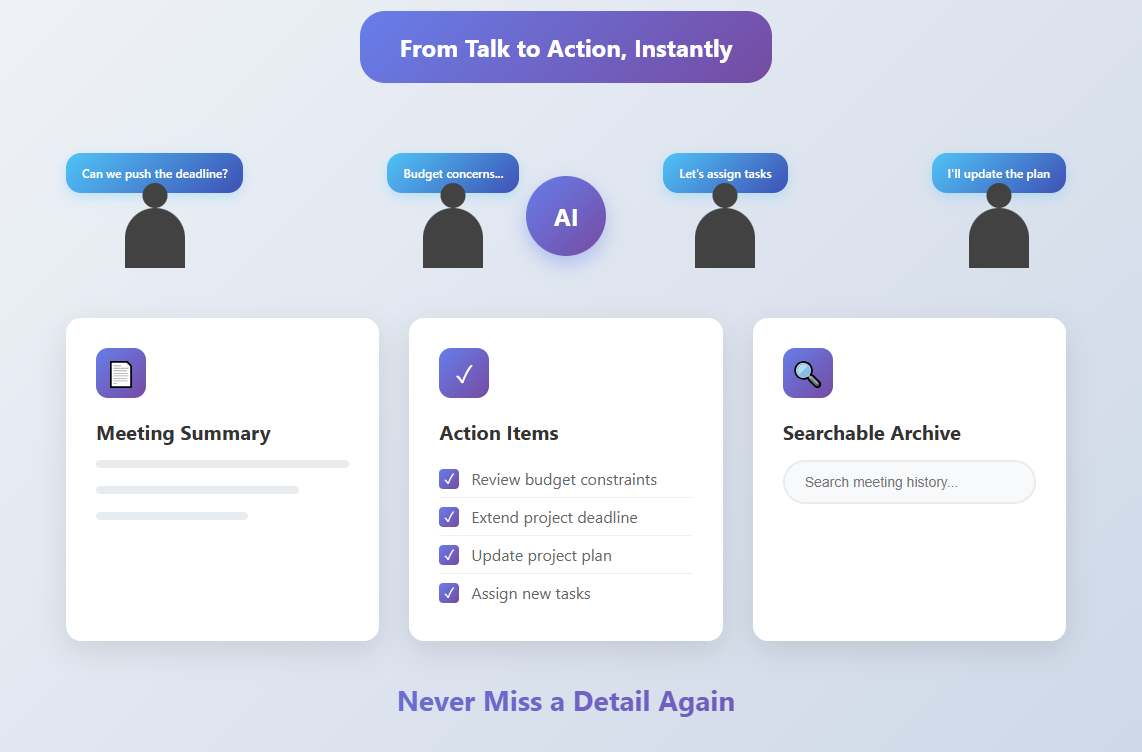
3. Risk identification and mitigation planning
Proactive risk management separates successful projects from failures. Generative AI offers:
- Predictive analysis of potential risks based on historical project data
- Generation of comprehensive risk registers with probability and impact assessments
- Custom mitigation strategies tailored to specific project contexts
- Continuous monitoring of risk factors throughout the project lifecycle
By analyzing patterns across thousands of similar projects, these tools can identify risks that human managers might overlook, providing a crucial safety net for complex initiatives.
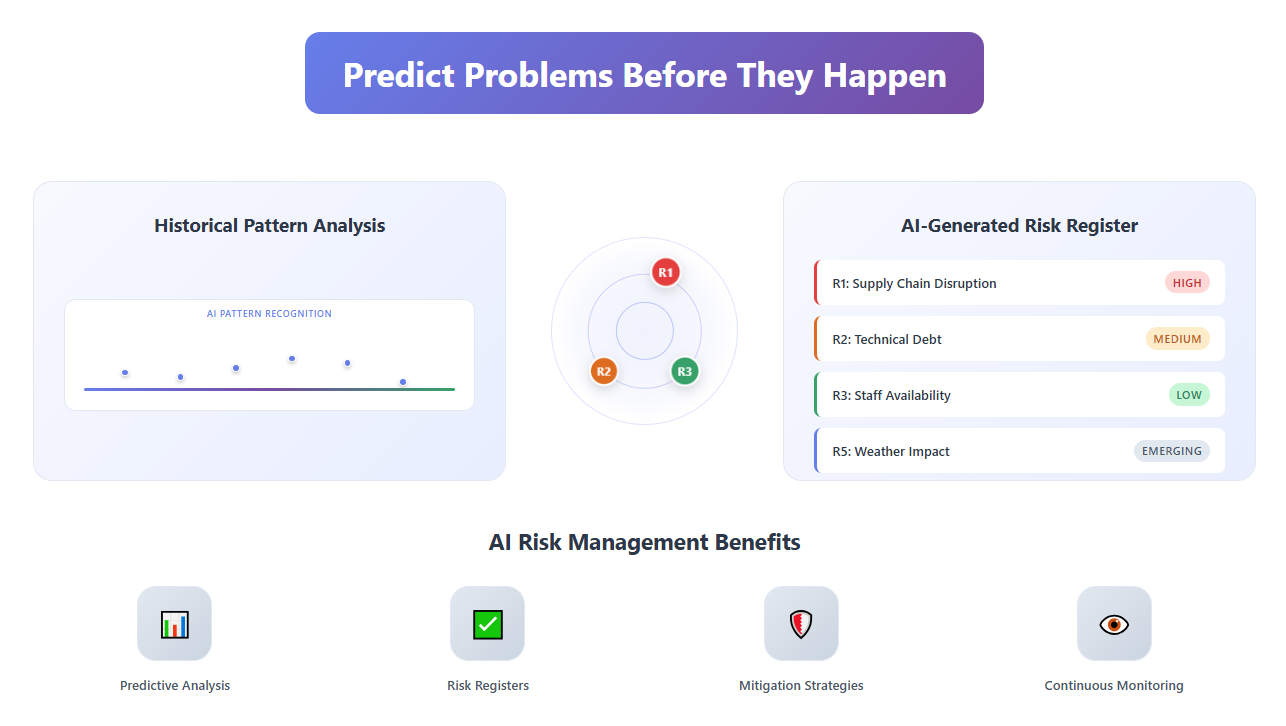
4. Resource allocation optimization
Finding the perfect balance of resources across projects remains one of management's greatest challenges. Advanced AI tools can:
- Analyze resource capabilities and availability across your organization
- Recommend optimal resource assignments based on skills and experience
- Simulate different allocation scenarios to identify the most efficient approach
- Predict resource bottlenecks before they impact timelines
A leading construction firm reported a 22% increase in project efficiency after implementing AI-powered resource optimization tools, translating to millions in annual savings.
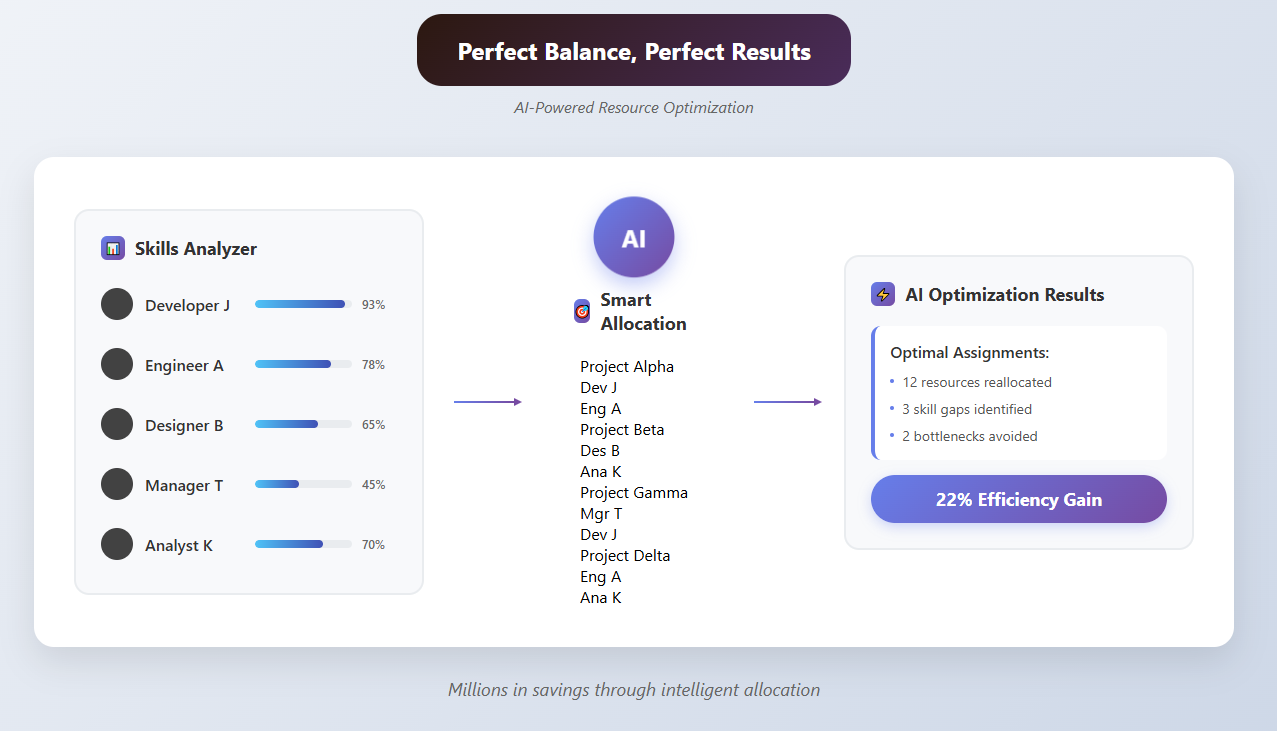
5. Schedule forecasting and bottleneck prediction
Project timelines rarely go exactly as planned. Generative AI can help by:
- Creating dynamic schedules that adapt to changing conditions
- Predicting likely delays based on historical performance data
- Identifying potential bottlenecks in advance
- Recommending schedule adjustments to keep projects on track
These capabilities enable proactive schedule management rather than reactive firefighting, dramatically reducing the stress associated with timeline slippage.
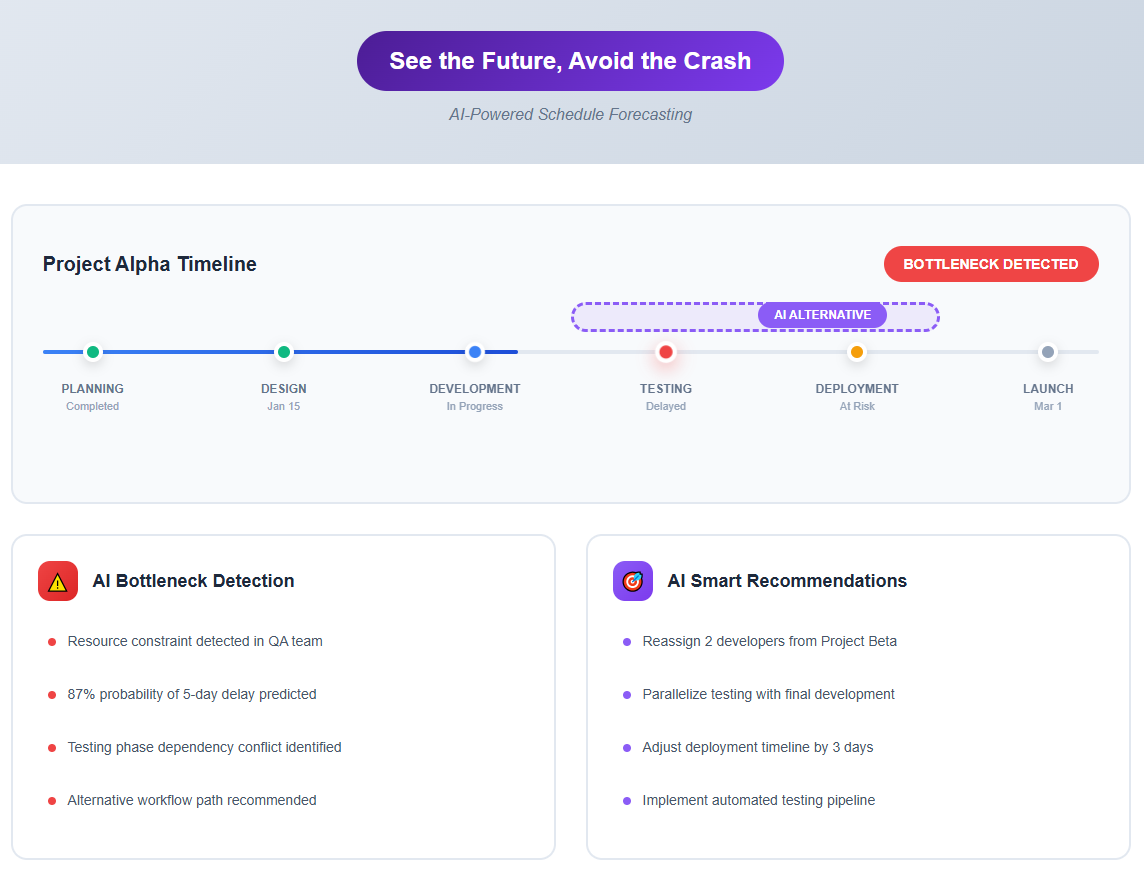
6. Stakeholder communication enhancements
Clear communication drives successful projects. The practical application of generative AI for project managers includes:
- Generation of tailored stakeholder updates based on recipient roles and interests
- Creation of compelling visualizations that communicate complex project data
- Translation of technical information into an accessible language for different audiences
- Sentiment analysis of stakeholder responses to guide communication strategies
These tools ensure that each stakeholder receives information in the format most useful to them, strengthening relationships and building trust throughout the project lifecycle.
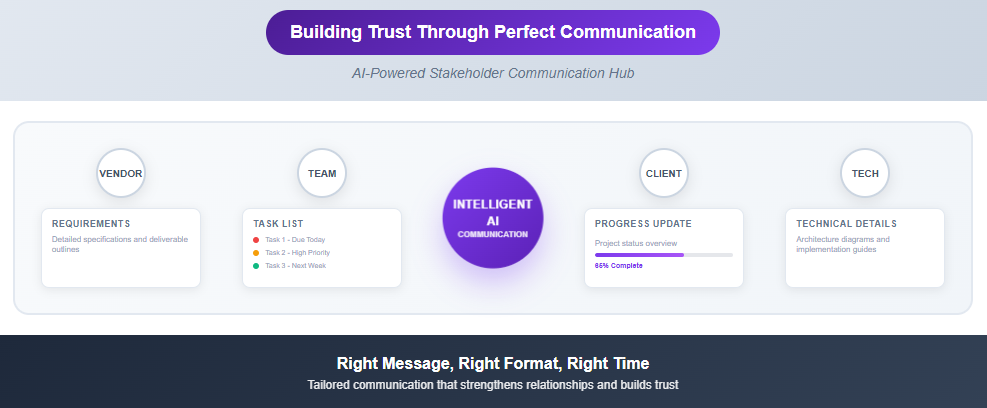
7. Knowledge management and institutional memory
Projects generate valuable knowledge that often disappears when team members move on. AI-powered knowledge management systems can:
- Automatically capture and organize lessons learned during project execution
- Create searchable repositories of project experiences and best practices
- Generate training materials from accumulated project knowledge
- Preserve institutional memory across organizational changes
This application ensures that hard-won insights benefit future initiatives, creating a virtuous cycle of continuous improvement.

8. Decision support systems
Project managers face complex decisions daily. Generative AI can provide:
- Data-driven recommendations for challenging project decisions
- Simulation of multiple decision outcomes to evaluate potential paths
- Identification of factors that might be overlooked in traditional analysis
- Real-time decision support during critical project phases
As one program director observed, "Having AI as a thought partner doesn't replace my judgment; it enhances it by ensuring I consider all relevant factors before making decisions.
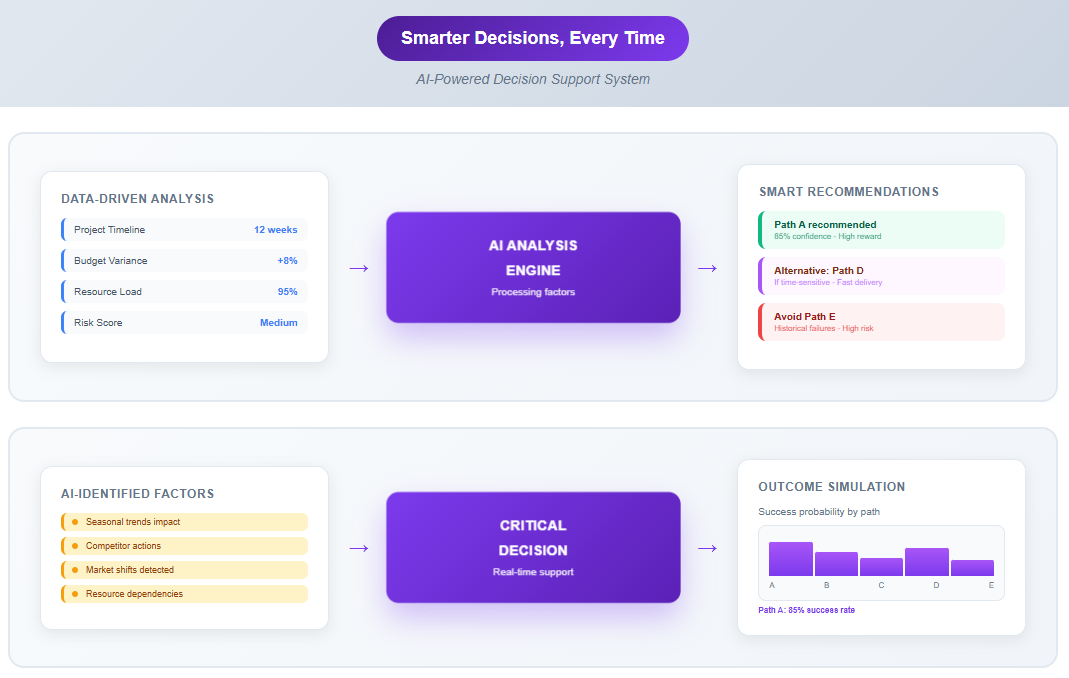
9. Intelligent project dashboards
Information overload can paralyze project managers. AI-powered dashboards can create:
- Customized dashboards that highlight the most relevant metrics for each viewer
- Natural language explanations of complex data trends
- Predictive indicators that flag potential issues before they appear in the data
- Interactive visualizations that allow intuitive exploration of project status
These intelligent interfaces, made possible by using AI in project management, transform raw data into actionable insights for faster decision-making.

10. Change management assistance
Change is inevitable in projects, but managing it effectively is challenging. Generative AI offers:
- Impact analysis for proposed changes across all project dimensions
- Generation of comprehensive change request documentation
- Communication templates to explain changes to affected stakeholders
- Adaptation strategies to minimize disruption from necessary changes
By streamlining change management processes, these tools help projects remain agile without sacrificing control or transparency.

Remember that generative AI for project managers is designed to augment human capabilities, not replace them.
The most effective project managers will be those who learn to collaborate with AI, using it to handle routine tasks while focusing their human creativity and judgment on the complex challenges that truly require the human touch.
Select the right GenAI tools for your project management stack
Choosing the right GenAI tool isn’t just about features; it’s about how well it fits your workflows, protects your data, and delivers measurable value.
Here’s a practical, structured approach to help project managers make confident, strategic decisions:

Start by building your evaluation framework
Before investing in any AI tool, establish a structured assessment framework that aligns with your organization's specific requirements:
- Define your primary pain points in the current project management processes
- Identify specific use cases where AI could provide the greatest value
- Establish clear success metrics to measure tool effectiveness
- Create a weighted scoring system based on your organization's priorities
A robust evaluation framework might include categories such as technical capabilities, ease of implementation, user experience, and long-term scalability. For each category, develop specific criteria that reflect your team's needs.
Prioritize seamless integration with your existing tools
The value of any AI tool multiplies when it works harmoniously with your existing tech stack. When evaluating integration capabilities, consider:
- API availability and robustness for connecting with your current systems
- Support for standard data formats used in your organization
- Ability to sync in real-time with your project management software
- Customization options for tailoring the integration to your workflows
GenAI tools for project management that offer pre-built integrations with platforms like Microsoft Project, Jira, or Asana can significantly reduce implementation time.
However, also evaluate the quality of these integrations; some may offer only basic functionality compared to what's possible through custom API development.
Verify security and privacy protections upfront
AI tools require access to your project data to function effectively, making a security assessment critical. Key factors to evaluate include:
- Data encryption standards both in transit and at rest
- Access control mechanisms and user permission management
- Compliance certifications relevant to your industry (ISO 27001, SOC 2, GDPR, etc.)
- Data retention policies and your ability to delete information when needed
- Transparency regarding how your data is used for model training
Remember that different projects may have varying security requirements. A defense contract project will need stricter security protocols than marketing initiatives, so categorize your projects by sensitivity level and match tool selection accordingly.
Calculate the full cost-benefit analysis
AI tools represent a significant investment beyond just the subscription cost. A comprehensive cost-benefit analysis should consider:
- Direct costs: Licensing fees, implementation services, training expenses
- Indirect costs: Internal IT resources, potential productivity dips during transition
- Expected benefits: Time savings, error reduction, improved decision quality
- Risk factors: Technology obsolescence, vendor stability, and adoption challenges
Capture both short-term gains and long-term strategic value in your analysis. Some benefits, such as improved institutional knowledge retention, may not show immediate returns but become increasingly valuable over time.
Real-world wins: 5 ways project managers solve big problems with GenAI
Below are five problem-solution case studies highlighting real GenAI use cases in project management and how GenAI delivers measurable value.
1. Construction: Boosting job site safety and compliance
Problem:
Shawmut Design and Construction, managing 150+ job sites, struggled to keep up with manual safety oversight, leading to increased risk of onsite accidents and regulatory issues, especially during COVID-19.
Solution:
They deployed AI-powered predictive safety monitoring across job sites. GenAI analyzed weather data, worker schedules, and equipment usage to flag potential hazards. During COVID-19, it ensured real-time compliance with social distancing via GPS tracking.
Result: Dramatic reduction in safety incidents and improved regulatory compliance, with more time available for project leads to focus on delivery.
2. Software development: Enhancing productivity with AI-powered code assistance
Problem:
Microsoft's software development teams faced challenges with lengthy development cycles, high administrative overhead, and the need to accelerate project completion rates while maintaining code quality across their vast development organization.
Solution:
Microsoft integrated AI-powered IT project management tools, including GitHub Copilot, into its software development processes. These tools utilized machine learning algorithms to analyze project data, track progress, identify potential bottlenecks, and assist with code generation.
Natural language processing facilitated better communication among team members by summarizing meetings and providing actionable insights.
Result:
Microsoft reported a 25% increase in project completion rates and a 30% reduction in time spent on administrative tasks. Additionally, 30% of Microsoft's code is now AI-generated, with improved communication and collaboration leading to higher team morale and a more cohesive work environment.
3. Supply chain management: Optimizing global logistics with AI-driven forecasting
Problem:
Amazon needed to accurately forecast demand for over 400 million products daily across various regions while optimizing inventory levels and minimizing costs in an increasingly complex global supply chain.
Solution:
Amazon deployed its Supply Chain Optimization Technology (SCOT) using deep learning and massive datasets. The AI system analyzes sales trends, social media activity, economic indicators, and weather patterns to predict demand fluctuations and enable dynamic inventory adjustments across warehouses.
Result:
When Amazon introduced deep learning to SCOT, forecasting accuracy jumped 15-fold in just two years, allowing Amazon to stock a bigger selection of goods, reduce stockouts, minimize excess inventory, and deliver to customers faster.
4. Healthcare: Enhancing patient flow with AI
Problem:
Children's Mercy Kansas City faced challenges in managing patient flow, leading to delays in bed assignments, extended emergency department (ED) wait times, and inefficient discharge processes.
Solution:
In collaboration with GE HealthCare, Children's Mercy launched the Patient Progression Hub, an AI-powered operations center. This system utilizes real-time data and predictive analytics to:
- Forecast patient demand up to 48 hours in advance, allowing for proactive staffing adjustments.
- Optimize bed placement by centralizing assignments and prioritizing timely transfers.
- Streamline discharge processes by tracking patient journeys and identifying potential delays.
Result:
The implementation led to significant improvements in patient flow, including reduced ED wait times and more efficient discharge planning. Patients experienced quicker access to care and timely discharges, enhancing overall satisfaction.
5. Financial services: Speeding up M&A due diligence
Problem:
Kraken’s $1.5B acquisition of NinjaTrader required deep due diligence on customer data and revenue streams, a process that typically takes weeks and slows high-stakes decisions.
Solution:
Kraken used Termina.ai, a generative AI platform, to rapidly ingest and analyze operations data, customer retention figures, and financial performance in hours, not weeks.
Result:
The M&A team was able to validate deal metrics quickly, make a faster acquisition decision, and gain executive confidence with AI-backed reporting.
GenAI in projects: 5 myths that sabotage success
Implementing generative AI is exciting, but let’s not pretend it’s all smooth sailing. Below, we debunk the common misconceptions and share tactical strategies to help you avoid the pitfalls many teams face.
Myth #1: “We can plug in GenAI and it’ll just work”
Reality: If your data is disorganized, GenAI won't perform as expected.
Tactical Fix:
- Conduct a project data audit
- Create standardized input formats across tools like Jira or Asana
- Automate data validation using AI-friendly templates
Clean data = clean outputs. AI is powerful, but it can’t fix chaos.
Myth #2: “My team will naturally start using it”
Reality: Without guidance and quick wins, most teams won’t engage.
Tactical Fix:
- Start with low-friction tasks (e.g., auto-generated meeting summaries)
- Assign internal champions and provide light-touch training
- Celebrate small victories to build momentum
Adoption is a campaign, not a checkbox.
Myth #3: “GenAI is always fair and objective”
Reality: Bias can be baked into models or the data you feed them.
Tactical Fix:
- Choose tools that offer bias detection settings and transparency controls
- Use GenAI for recommendations, not decisions, especially in HR or task delegation
- Establish an AI ethics policy early
AI is a co-pilot, not the pilot, especially in decisions that affect people.
Myth #4: “Integration will be quick”
Reality: Legacy systems often slow or block AI integration.
Tactical Fix:
- Prioritize tools with open APIs or Zapier-style connectors
- Use GenAI tools in parallel mode for reporting or documentation first
- Gradually bridge them into your main PM system
Think of GenAI as a satellite tool until your core stack is ready.
Myth #5: “Leadership just needs the tech to work”
Reality: Expectations can be sky-high and impatient.
Tactical Fix:
- Align stakeholders early with realistic timelines
- Share a phased rollout plan with metrics
- Highlight early impact with before-and-after snapshots
Set the tone: AI wins are incremental, not instant.
Take the next step: Integrate AI into your project workflow
This overview of generative AI in project management shows that AI isn't about replacing you - it's about amplifying your impact. From reducing admin load to forecasting risks and aligning stakeholders, these tools free you to lead with clarity and confidence.
As projects grow more complex, the smartest PMs won’t just manage - they’ll innovate, adapt, and thrive with AI at their side.
Ready to elevate your project game? Explore how Dart helps modern teams integrate GenAI with real-world execution.
Frequently asked questions (FAQs)
What are the key benefits of GenAI for project managers?
GenAI reduces administrative overhead by up to 70%, automates routine documentation, provides predictive risk analysis, and enables data-driven decision making. This frees project managers to focus on strategic leadership and stakeholder alignment.
What tasks does GenAI automate for project managers?
GenAI automates repetitive tasks like drafting reports, making project schedules, and generating meeting agendas, freeing project managers to focus on high-value activities such as strategy and leadership.
Can GenAI help with cross-functional team coordination?
Absolutely. GenAI tools can provide personalized task summaries, surface interdependencies, and create shared dashboards that make cross-functional collaboration seamless and transparent.
What is one way GenAI can assist in predictive planning for project managers?
GenAI analyzes historical project data to predict potential bottlenecks, delays, and resource conflicts before they occur, allowing project managers to adjust schedules and resource allocation proactively.
How can project managers safeguard data in GenAI applications?
Prioritize tools with strong data encryption, verify compliance certifications (ISO 27001, SOC 2, GDPR), implement access controls, establish clear data retention policies, and ensure transparency about how your data is used for model training.
How can generative AI improve project status reporting?
GenAI automatically compiles data from multiple sources to generate comprehensive status reports, creates tailored updates for different stakeholder groups, and provides real-time insights with natural language explanations of complex project metrics.
What is one way a project manager can use GenAI to improve business acumen?
GenAI can analyze historical project data and industry benchmarks to generate market-aware project insights, helping PMs make more commercially sound decisions and align deliverables with business goals.
What's the best way to start using generative AI for project management?
Start with small, high-impact areas like meeting summaries, automated reports, or AI-enhanced risk logs. Gradually expand to timeline forecasting, workload balancing, and decision support tools as your team becomes more comfortable.


%20(1).jpg)
_light%201.png)





